South African Airways – History of the Flying Springbok
- Garth Calitz
- Nov 24, 2020
- 9 min read

South African Airways was formed on 1 February 1934 following the acquisition of Union Airways by the South African government. Forty staff members, along with one de Havilland DH.60 Gypsy Moth, one de Havilland DH.80A Puss Moth, three Junkers F.13s, a leased Junkers F13 and Junkers A50 were among the acquired aircraft. Upon acquisition, the government changed the airline's name to South African Airways fell under the control of the South African Railways and Harbours Administration (now Transnet), charter operations started that year.

de Havilland DH.60 Gypsy Moth

de Havilland DH.80A Puss Moth

Junkers F13

Junkers A50
On 1 February the following year, the carrier acquired Suidwes Lugdiens / South West Airways (now Air Namibia), which had since 1932 been providing a weekly air-mail service between Windhoek and Kimberley. During this time, South African ordered three Junkers JU 52 aircraft, which were delivered in October 1934 and entered service 10 days later.

Junkers JU 52
These aircraft were configured to carry 14 passengers, along with four crew. They enabled thrice-weekly Durban–Johannesburg services, with weekly services on the Durban–East London–Port Elizabeth–George/Mossel Bay–Cape Town route. On 1 July 1935, SAA moved its operations to Rand Airport as it became increasingly obvious that Johannesburg would become the country's aviation hub, which coincided with the launching of Rand–Durban–East London–Port Elizabeth–Cape Town services. From July the following year, a weekly Rand–Kimberley–Beaufort West–Cape Town service commenced; in April 1936, all Rand–Cape Town services were taken over from Imperial Airways. A fourth JU 52 soon joined the fleet.
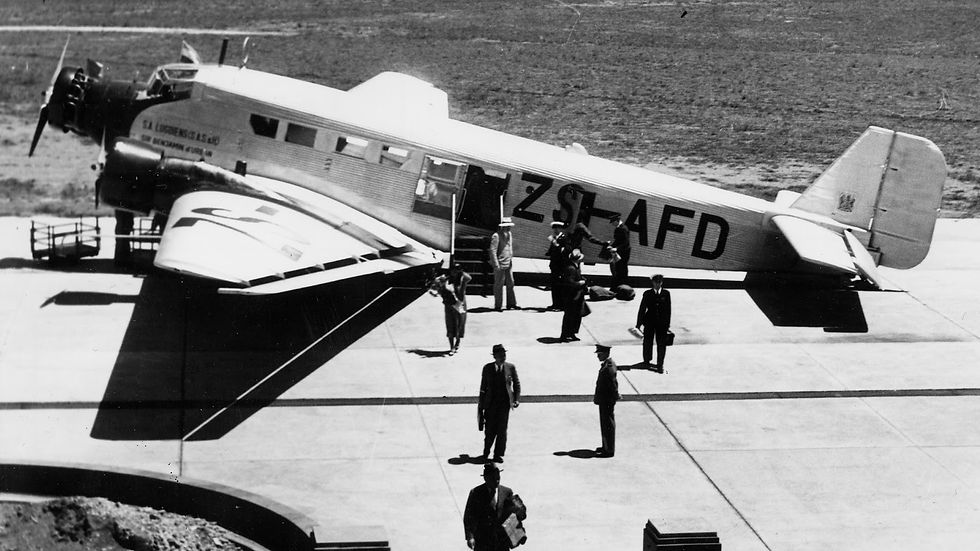
Orders for a further ten JU 52 aircraft, along with eighteen Junkers JU 86's and seven Airspeed Envoys (four for the airline and three for the South African Air Force) were placed. This raised the number of JU 52s to fourteen, although three older models were sold when deliveries of the newer JU 52s began. The airline experienced a rapid expansion during this time, but also suffered its first accident; one of the newly delivered JU 52s crashed after takeoff from Rand Airport in July 1937, with one reported fatality. From 1 February 1934 until the start of World War II, SAA carried 118,822 passengers, 3,278 tonnes of airmail and 248 tonnes of cargo, which were served by 418 employees. On 24 May 1940, all operations were suspended.

Junkers JU 86
Following the war, frequencies were increased and more routes were opened, which necessitated the conversion of three South African Air Force Envoys to passenger layout. These aircraft would prove to be unsuitable for passenger and cargo services and were returned to the SAAF after the arrival of the Junkers JU 86's. The main aircraft of SAA in the 1930s was the Junkers Ju 52. Other types used in the 1930s included eighteen Junkers Ju 86s, which served from 1937 onwards.
The slow growth continued during the 1940s, though the airline was effectively closed for the duration of World War II. In 1944 SAA began operating 28 Lockheed Lodestars to restart domestic services and by 1948 SAA was operating nineteen examples. These were withdrawn in 1955.
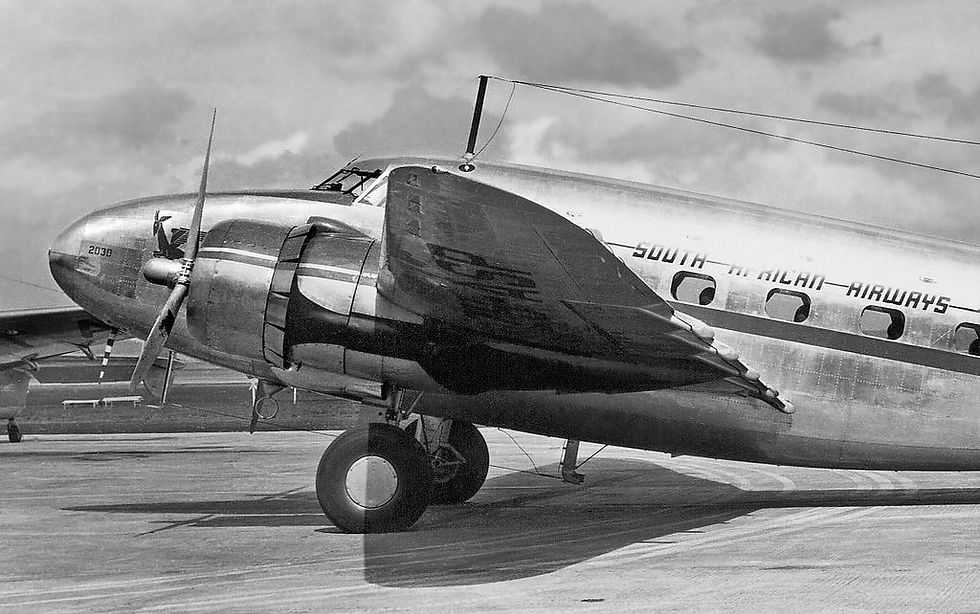
Lockheed Lodestar
On 10 November 1945, SAA achieved a longtime company goal by operating a route to Europe when an Avro York landed in Bournemouth, England, after the long flight from Palmietfontein Airport near Johannesburg.
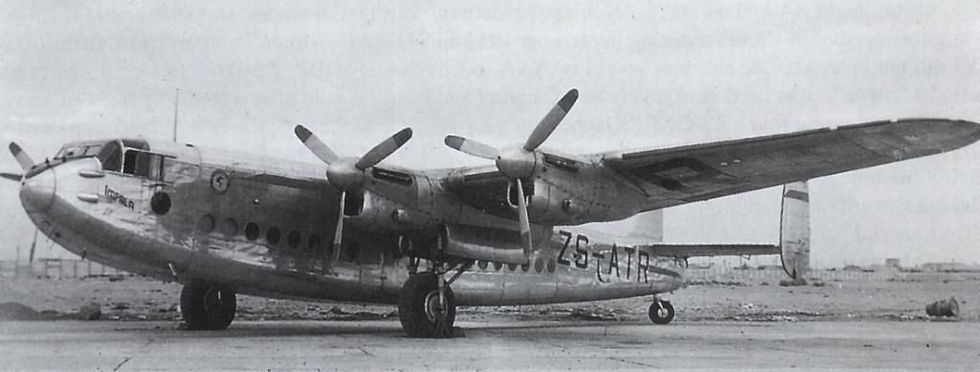
Avro York
These were replaced by the Douglas DC-4 from 1946 onwards, which in turn was replaced by the Lockheed Constellation on international routes in 1950. Also of note in the post-war era was the DC-3 Dakota, of which eight served with SAA, the last example being withdrawn as late as 1970.

Douglas DC-4

Douglas DC-3
From 1946, passengers and cargo carried increased, along with the size of SAA's fleet and staff. As the Skymasters arrived, out went the Avro Yorks, back to BOAC. Air hostesses were introduced in September 1946, at first on domestic routes, then on Springbok Services. The two de Havilland Doves were introduced at the end of the year; these aircraft were utilised on internal services for a short time and were sold within a few years. The 28-seat Vickers Viking served the airline briefly, before being sold to British European Airways.

de Havilland Dove
Palmietfontein Airport replaced Rand Airport as SAA's hub in 1948. In June 1948, SAA began to show films onboard its Skymaster aircraft.
SAA received four Lockheed Constellations, its first pressurised aircraft, in August 1950. They provided scheduled service to London's Heathrow airport. Initially, the route from Johannesburg was flown via Nairobi, Khartoum and Rome. The Constellation's higher speed and longer range enabled fewer stops and greatly reduced the flying time to London.

Lockheed Constellations
The jet age arrived in South Africa on 3 May 1952 when a BOAC de Havilland Comet arrived in Palmietfontein after a 24-hour journey from England with five refuelling stops en route. South African chartered two Comets from the British airline; on 4 October 1953, when Comet G-ANAV left London for Johannesburg. On the same day, Tourist Class was introduced on the 58-seater Lockheed Constellation on the Springbok Service. The two chartered aircraft sported both BOAC and SAA titles and logos but were operated by South African crews.

BOAC de Havilland Comet
In 1956 South African Airways introduced the Douglas DC-7B, capable of long-range operations and probably the fastest piston-engine airliner in the world. SAA exploited the aircraft's performance by introducing it on Johannesburg–London with only one stop at Khartoum. This was known as the East Coast express, taking 21 hours to complete, versus BOAC's inaugural Comet flight between the two cities of 24 hours. This later became the West Coast express when the technical stop at Khartoum was transferred to Kano, Nigeria, resulting in a shortened flying of 18 hours. The fortnightly Wallaby service, routed Johannesburg–Mauritius–Cocos Islands–Perth, Australia, started in November 1957.

Douglas DC-7B
After a host of accidents involving SAA's and other airlines' Comets, the airline ordered three Boeing 707–320 Intercontinentals on 21 February 1958, with the first delivered on 1 July 1960. Three months after arrival, on 1 October 1960, the Boeing 707 was deployed on the airline's flagship Springbok Service, trimming the flying time to 13 hours. Other changes brought about by the 707 were a livery change, to an orange tail with blue and white markings, as well as improved comfort, range and speed. A 707 replaced the DC-7B on the Wallaby route in 1967; Cocos Islands was dropped, while Sydney became the terminus. Flights to New York, via Rio de Janeiro, started on 23 February 1969 using a 707. The first 707 of SAA landed in Europe in October 1961 with a nine-hour flight to Athens.
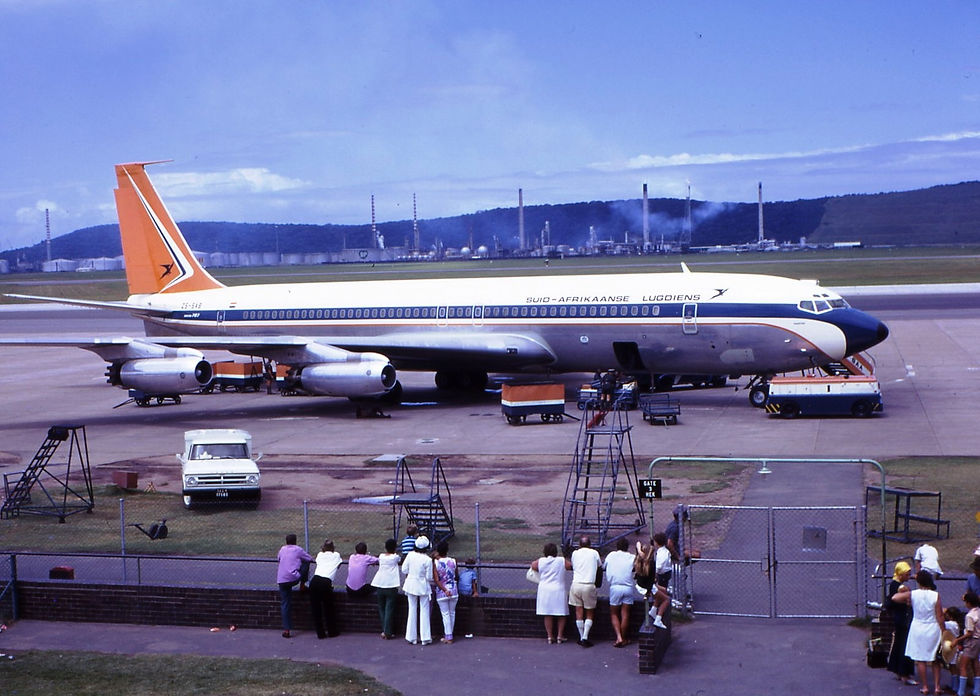
Boeing 707–320
The jets arrived during a period when most African countries, except SA's neighbours, denied South African airlines the use of their airspace, necessitating long detours. In 1967 the Skymasters, Constellations and DC-7Bs were being retired, replaced by the Boeing 727 trijet the following year to complement the Boeing 707. The choice of 727 was based on the geography of the destinations to which it would fly; for example, Johannesburg is 1,694 metres (5,558 ft) high and hot, where the 727's wings and other technical capabilities enable it to operate out of such airports.
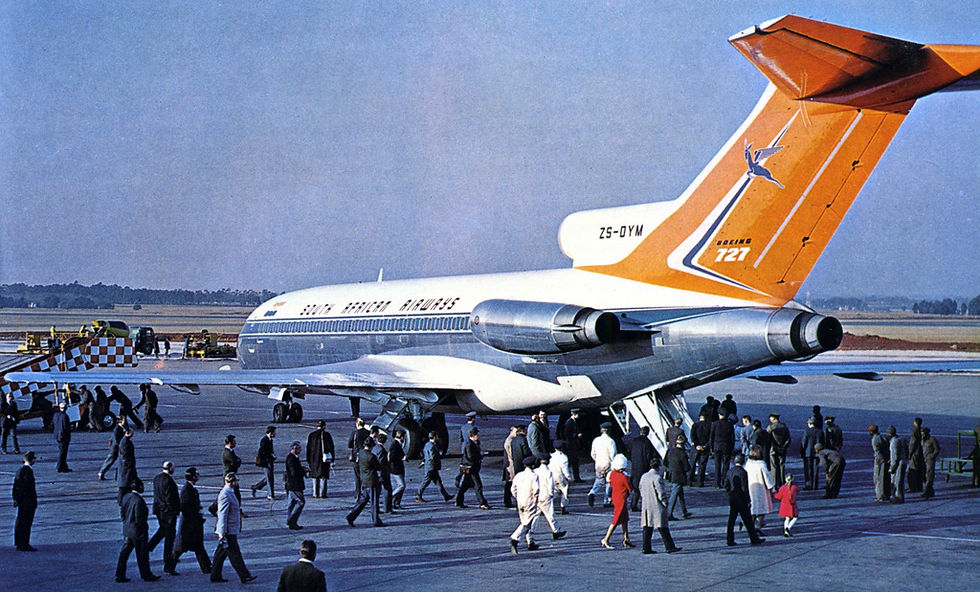
Boeing 727
On 13 March 1968 SAA ordered five Boeing 747-200Bs. The first, Lebombo ( ZS-SAN), was delivered on 22 October 1971 after a 3-stop flight from Seattle. It was placed into service in December and proved very popular.
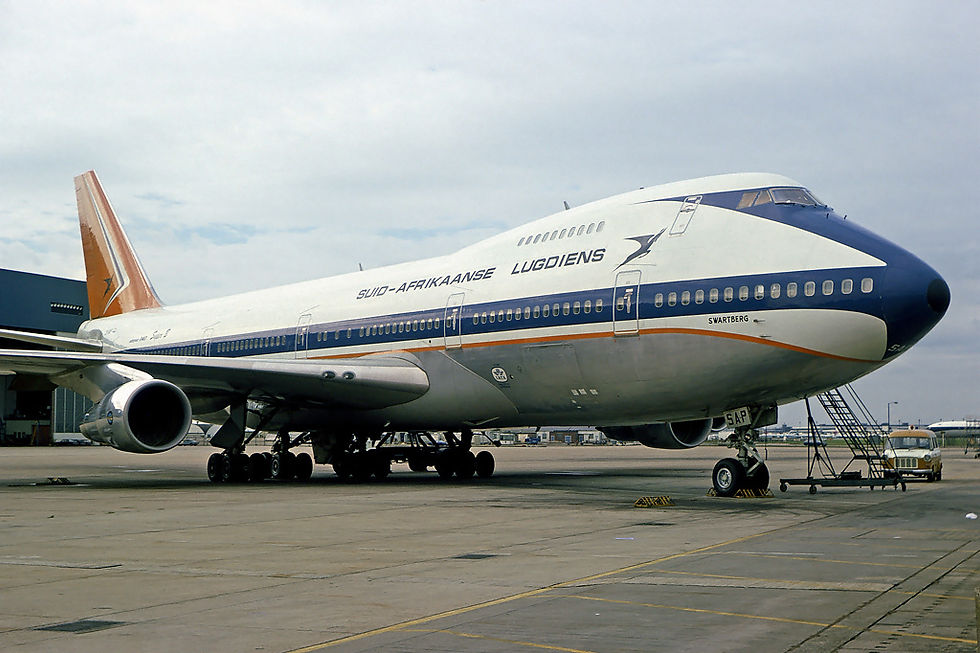
Boeing 747-200
SAA eventually operated 23 brand-new "Jumbo Jets", including the −200M (first delivered in 1980), −300 (1983), −400, and the long-range Boeing 747SP. The 747SP, especially, was acquired to overcome the refusal of many countries to allow SAA to use their airspace by exploiting its long-range capabilities, as well as to serve lower-density routes which were unsuited to the 747-200.
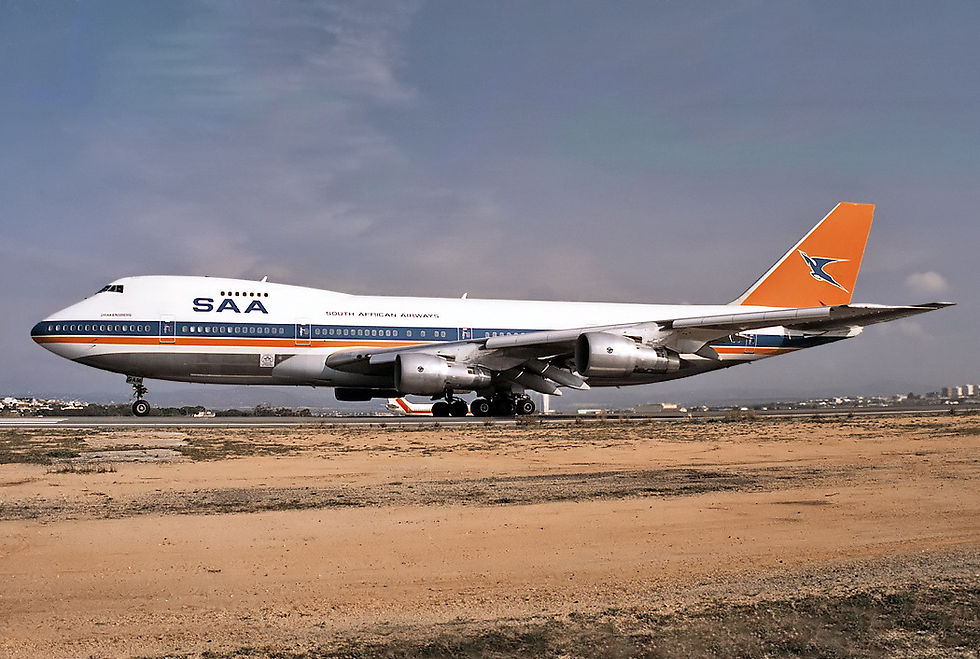
Boeing 747-400
Six were delivered starting 19 March 1976. To demonstrate the 747SP's performance, one was delivered from Seattle to Cape Town non-stop, an airliner distance record that stood until 1989. The first 747SP arrived in South Africa on 19 March 1976. As the 747 entered service, its smaller siblings, the 707s, were converted to combi – passenger/cargo – configurations, and high-density seating.
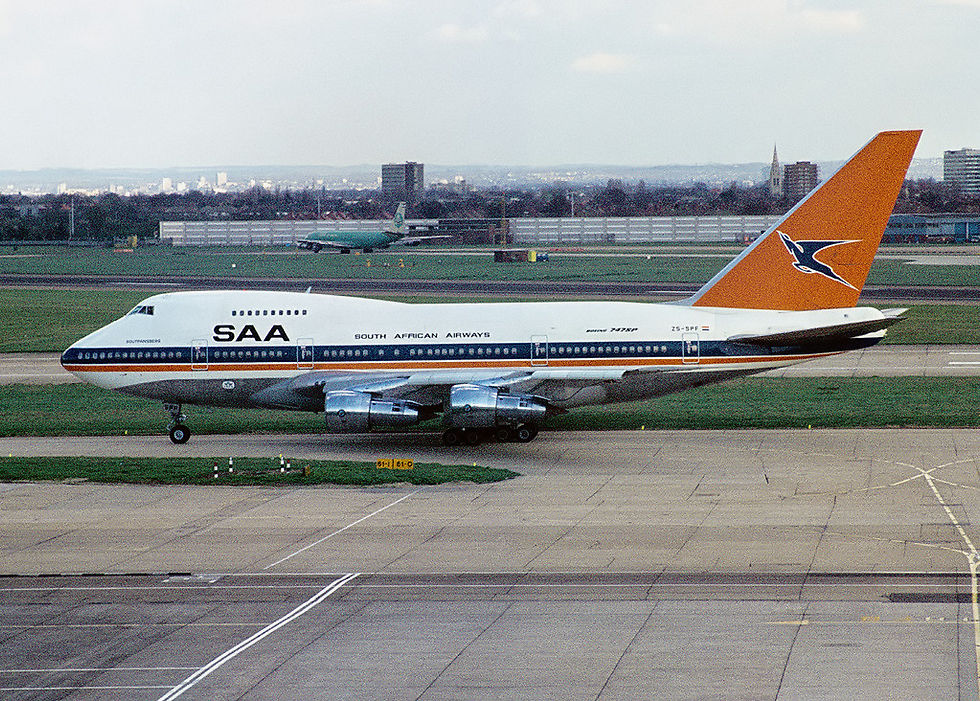
Boeing 747SP
SAA opened a route to Asia, with Boeing 707 flights to Hong Kong via an intermediate stop at the Seychelles Islands in June 1974. In 1980, SAA began flights to Taipei using a Boeing 747SP; Mauritius had earlier replaced the Seychelles for the Hong Kong service. South Africa became one of the few countries in the world to recognise the government of the Republic of China on Taiwan.
Because some African countries denied SAA the use their airspace, SAA bypassed the 'bulge' of Africa, usually via Ilha do Sal - a detour of almost 3,000 kilometres (1,900 mi). Another bypass was via Tel Aviv, which doubled the distance and flying time involved. European airlines were allowed to fly over Africa when flying to South Africa, usually via Nairobi and later nonstop.
On 26 December 1980, the last South African Airways Boeing 707 service was operated between Paris and Johannesburg. Its touchdown ended the 20-year career of the 707. The quadjet was replaced by the world's first wide-body twinjet, the Airbus A300, which had entered revenue service in 1976.

Airbus A300
The 727s were eliminated by 1983, replaced by the more economical Boeing 737. When countries withdrew landing rights for SAA, the airline leased its aircraft and crews to Canada, Mauritius, Brazil and Morocco.

Boeing 737
Due to international opposition to apartheid during the 1980s, SAA's offices were attacked. In Harare, Zimbabwe, its offices were badly damaged after protesters went on a rampage. The US Comprehensive Anti-Apartheid Act of 1986 banned all flights by South African–owned carriers, including SAA. In 1987, SAA's services to Perth and Sydney in Australia were ended, in light of the Australian Government's opposition to apartheid.

The South African Airways Museum Society opened its doors to the public at Jan Smuts International Airport. The organisation was formed by South African Airways employees and outside parties with the mission of preserving South African aviation history, especially SAA itself. Based at Transvaal Aviation Club, Rand Airport, Germiston, it was founded after the restoration of the Junkers Ju 52. Since then, many aircraft have joined the SAA Museum Society's collection relating to South African aviation.
With the demise of apartheid in 1990, SAA started services to former and new destinations in Africa and Asia. On 1 June 1990 South African companies signed a domestic air travel deregulation act. Flights to New York City's JFK International Airport resumed in November 1991 and SAA's planes were able to fly for the first time over Egypt and Sudan, on 8 September. The airline launched flights to Milan on 1 June during that year, and services to Athens were re-introduced. Also, an interline with Aeroflot was established.
The first of SAA's eight Boeing 747-400s, named Durban, arrived in South Africa on 19 January 1991. The airliner was unusual in that two different turbofan engines were operated. Six Roll-Royce RB211-524H-powered examples were ordered; the other two, part of an unfulfilled Philippine Airlines order, had General Electric CF6-80C2B5Fs. Winglets, structural changes, as well as fuel-efficient engines enabled these aircraft to fly non-stop from South Africa to the East coast of the United States. The arrival of Boeing's newest jumbo jet perhaps overshadowed the acquisition by SAA of the world's first commercial fly-by-wire airliner, the Airbus A320, to assist and enhance services within the country and on regional services. Boeing 767s arrived in August 1993 and flew on African, Southern European and Middle Eastern routes. They were retired within ten years.
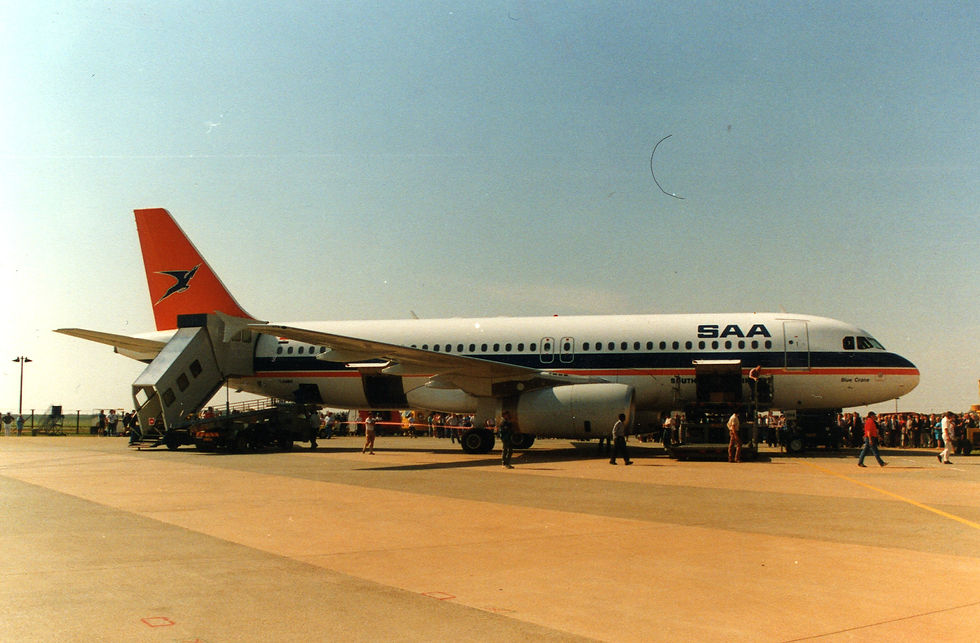
Airbus A320
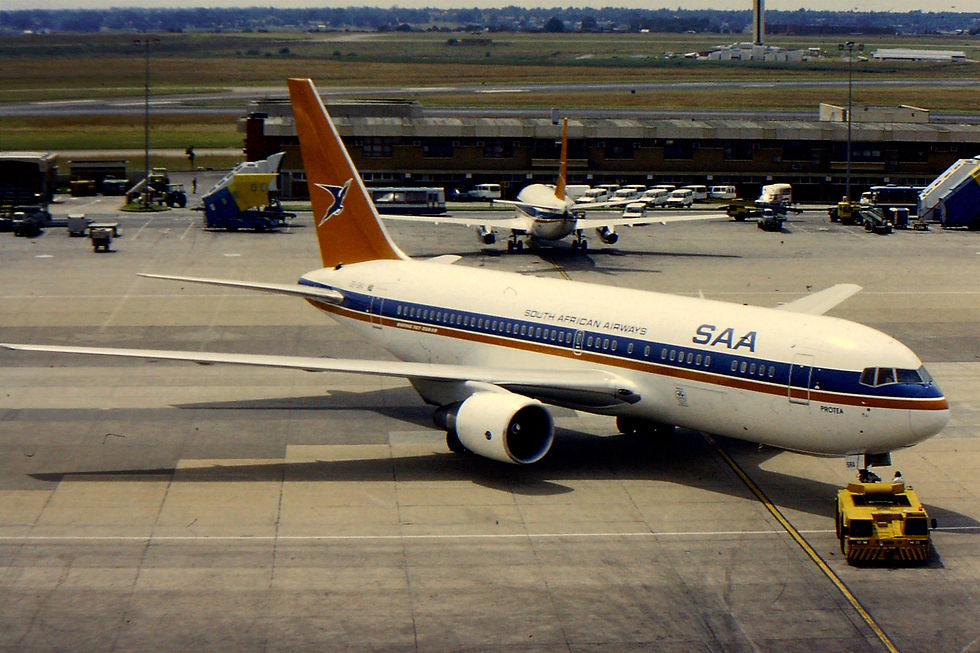
Boeing 767
During 1992, SAA began flights to Miami with a Cape Town to Miami International Airport route, and re-entered Australia, flying directly to Perth with a same-day return "shuttle" service to Sydney. This year also saw codesharing agreements with American Airlines and Air Tanzania. There were direct flights to Bangkok and Singapore; the latter was discontinued by 1996. The airline Alliance, a partnership between SAA, Uganda Airlines and Air Tanzania, also began. SAA greeted its passengers in four different languages during domestic flights: English, Zulu, Afrikaans and Sotho, while passengers on international flights were also greeted in the destination's language.
On 24 April 1994, South African Express (SA Express), a feeder airline service of South African, began operating after a 3-year preparation process begun in 1991 when the regional airline was granted its operating license. SAA initially held a 20% stake in SA Express (Alliance Airline Holdings held 51%, SA Enterprises, 24.9% and Abyss Investments, 4.1%). SA Express took over some of South African's low-density domestic routes.
In 1995, Lufthansa started a codesharing agreement with SAA, and SAA commissioned Diefenbach Elkins and Herdbuoys to lead its change of image. SAA's Voyager and American Airlines' AAdvantage frequent flier clubs joined together.
As of April 1996, South African Airways employed 11,100 people, of whom 3,100 were engineers. It owned and operated 48 aircraft, and served 34 destinations from its hubs at Cape Town, Durban and Johannesburg.
In 1997, SAA replaced the Springbok emblem and the old national colours of orange, white and blue with a new livery based upon the new national flag, with a sun motif. The airline's name on its aircraft was changed from the Afrikaans name Suid-Afrikaanse Lugdiens to South African. As a symbol of the new rainbow nation, one of SAA's 747-300s, named Ndizani (registration ZS-SAJ), was painted in bright colours. This special-liveried 747-300 transported South African athletes to the 1996 Summer Olympics in Atlanta. The airline started online ticket sales and formed an alliance with SA Airlink and SA Express.

Ndizani






























Comments